There are several subtle and easily recognizable differences between the Mourning Dove (Zenaida macroura) and Eurasian Collared-Dove (Streptopelia decaocto). However, the most distinguishing and easy-to-spot difference is the neck markings on each bird.
The Eurasian Collared-Dove, or EUCD, has a very distinctive, bold black collar around the base of the neck. Comparatively, the Mourning Dove, MODO, only has a small black dot at the lower edge of the cheek.
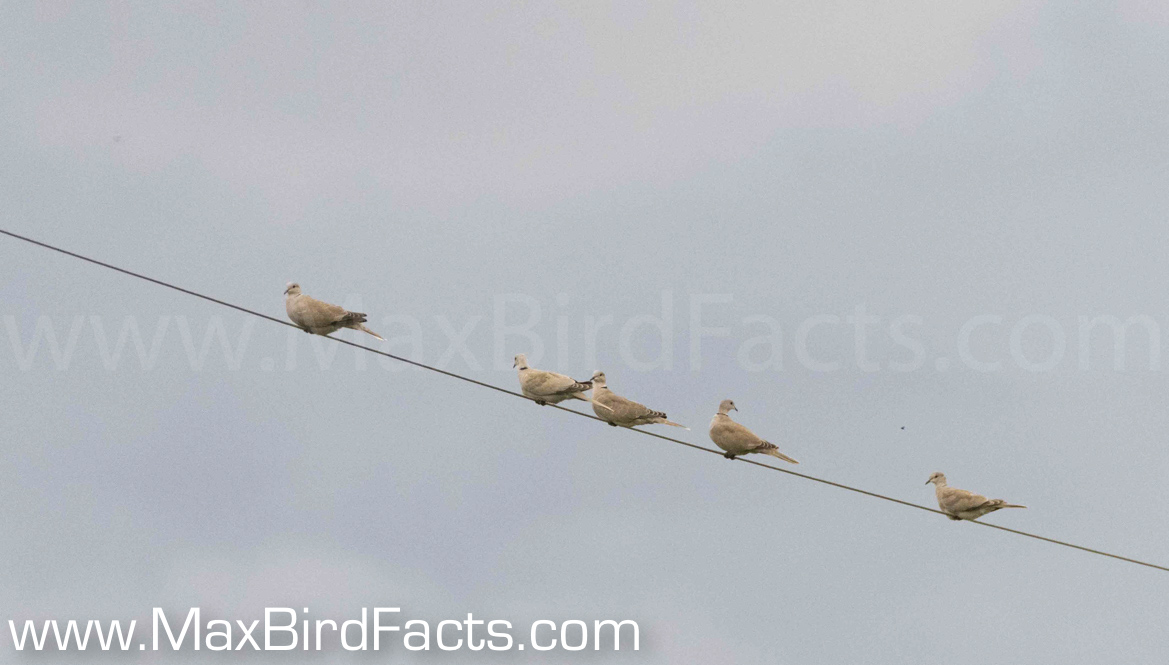
But these aren’t the only differences between these birds. In this article, I’ll go over five main things to look out for:
- The main, easiest identifying feature of the species.
- Orbital ring and eye coloration.
- Tail shape.
- Wing shape.
- Overall body shape and size.
Hopefully, after knowing these, you’ll be able to confidently identify one of these doves without looking at the neck marking.
This will get a bit technical, which is the nature of avian identification. However, I’ll try to keep the sciencey words to a minimum and define them as we go.
Overall Aspect & Coloration
Starting with the Mourning Dove, the bird’s dorsal aspect (back) is grayish-brown with black speckling on the wing coverts (shoulders and upper arm). Ventrally (throat, breast, and belly), we see a much more uniform, light brown to almost pinkish.
The primary flight feathers have a darker, sooty-gray appearance when the wings are folded. Interestingly, we can even tell the sex of the adult dove.
Male Mourning Doves show a small amount of sexual dimorphism in the way of a colorful neck marking, but this is only really visible when it hits the light. These iridescent feathers give off a beautiful yellow-green color.
The male’s breast feathers will also change to a more pinkish hue during the mating season. Overall, determining the sex of the dove you’re looking at can be a very challenging task.
Again, that black spot at the corner of the cheek or jaw is another key ID marker. The dove can hide its spot by puffing out its feathers, though, so it isn’t always available.
Adults will typically have a teal or turquoise orbital ring. A MODO’s eye is darkly colored and generally a dark brown (this is crucial to observe).
The gape, the flesh at the mouth’s edge, can also have subtle pink color. The beak itself is near-black and very dark besides this.
Finally, the Mourning Dove’s feet are notably pink compared to other doves, and this is an excellent feature to spot for identification. If you see a dove perched on a fence, powerline, or feeder, definitely try to get a look at its foot color.

The Eurasian Collared-Dove is relatively similar in appearance dorsally, having a grayish-brown aspect but lacking the spots seen on the Mourning Doves. Their ventral aspect is a little lighter than the MODO’s, having an almost ashy-tan look.
Like the Mourning Dove, the primary flight feathers are much darker than the coverts with the wings folded. Also, just like the Morning Dove, the edges of the feathers are lighter in color than the main shaft.
Unlike the MODO, there is no definitive way to determine the sex of a Eurasian Collared-Dove in the field, meaning they are monomorphic.
The key feature of this species is its collar. The impressive black band runs along the nape of the dove’s neck and is surrounded by white feathers to create a striking contrast.
Unlike the black spot we saw on the Mourning Dove’s cheek, this collar can’t be completely hidden. Yes, if the feathers are raised, they can cover most of the collar, but a thin, black band will still be visible.
Adult Eurasian Collared-Doves also have a white orbital ring. However, probably the most spectacular feature of these birds is their eyes.
Eurasian Collared-Doves possess crimson-red eyes. These are very clearly different compared to the Mourning Dove’s dark brown.
Even at a fair distance away or in a photo that isn’t zoomed in much, the eye color of these doves is instantly recognizable.
Their beak and gape are much more evenly black than the pink gape we saw in the Mourning Dove.
Another slight but discernible difference is the foot’s color. EUCD have a much darker pink coloration to their feet compared to the MODO.
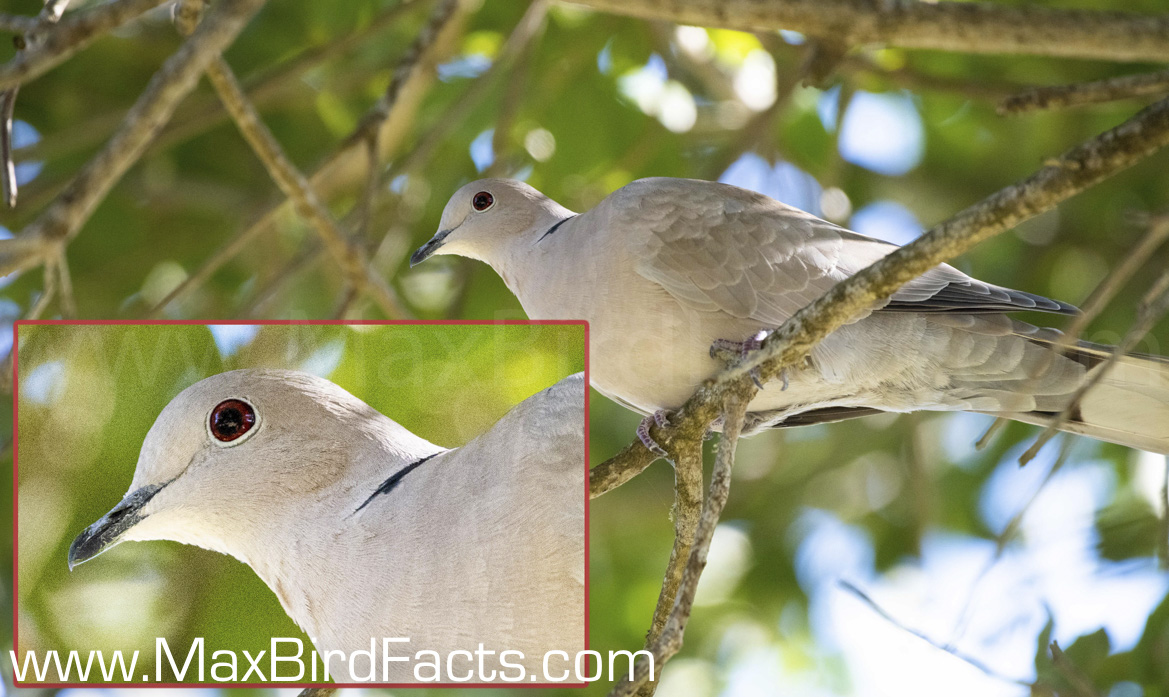
Physical Attributes
I wouldn’t expect an experienced birder to know the difference between these two species if faced with a silhouette alone. However, there are some features of note, specifically the wings, tail, and beak.
The body shape and size of these two birds are exceptionally subtle. Eurasian Collared-Doves appear heftier and stouter than the Mourning Dove’s more slender, delicate build.
The Eurasian Collared-Dove is, on average, a few inches longer and a few ounces heavier than the Mourning Dove. However, the Mourning Dove has a noticeably longer wingspan and tail.
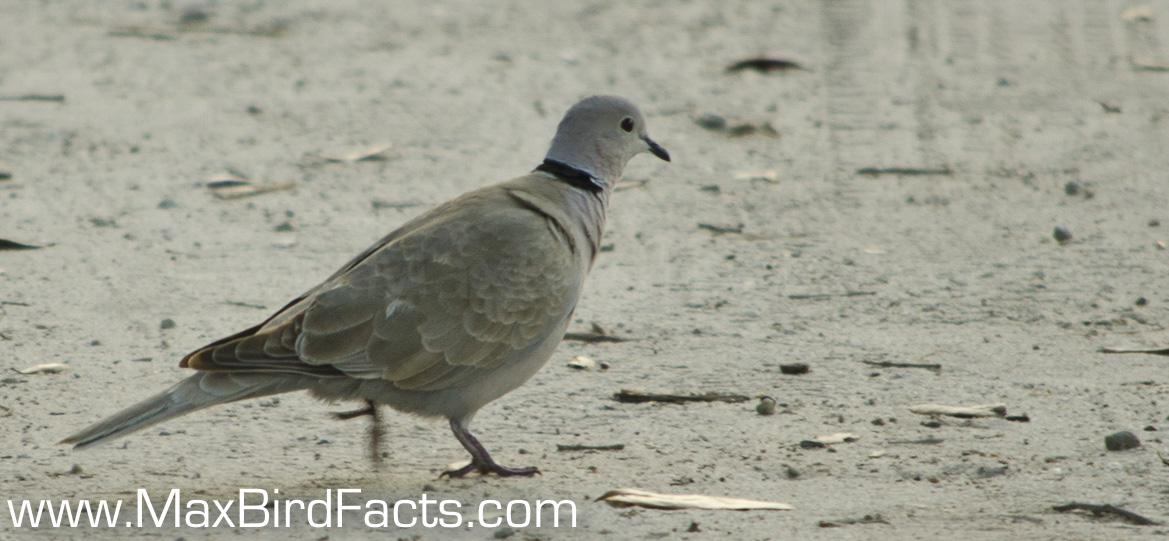
The wings and tail are a very good tell between the two species.
MODOs have sharply-pointed, high-aspect ratio wings. This means they are designed for high-speed, highly-efficient flights. In addition, a Mourning Dove’s tail is long and pointed, distinct compared to all other dove species they share ranges with.
Eurasian Collared-Doves have more rounded, broader wings. These are still perfectly adequate for high-speed flight but are more suited for rapid take-off. A EUCD’s tail is much shorter and appears like a more traditional dove-tail. This fan shape is very versatile, just like its wing shape.
The beak is also something you might want to take into consideration.
This is a very slight difference, and if you have the time to check this feature, you have probably spotted some of the more obvious ones. Even still, the Mourning Dove’s beak is slightly shorter than the Eurasian Collared-Dove’s.
The beak size can be somewhat tricky to tell when you’re at a distance from these birds, but still helpful to keep it in the back of your mind.
In-Flight Identification
Again, starting with the Mourning Dove, their flight is very distinct. Dorsally we’ll see the spots on the coverts breaking up the overall uniform brown wings.
Looking at the bird ventrally, we will see the uniform soft, light brown to almost pinkish head, throat, and breast. The underwing is light gray and white on the underside of the tail.
We can see the white tips and black subterminal bands when the tail feathers fanned out. There is a very apparent taper to the tail as well, the middle is the longest part, and both ends climb to reach it.
The tail is nearly as long as the dove’s body, and this should be the primary thing you look for when the bird is in flight.
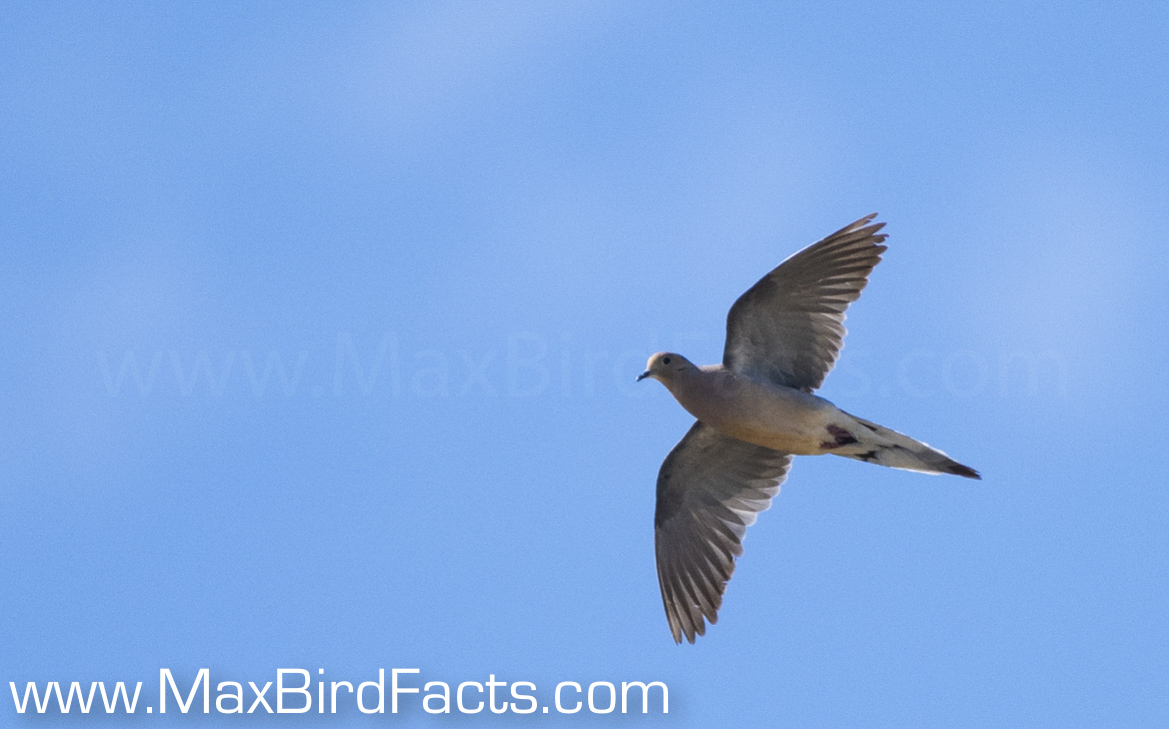
Mourning Doves also have a thrilling sound they produce. As the dove takes flight, specialized feathers vibrate from the wind passing through them, and these vibrations create the Mourning Dove’s iconic wing whistle.
These whistles act as a warning signal to other doves or animals in the area when a threat is approaching. The intensity of the whistle is controlled by how hard the dove takes off. If the thing that caused the dove to lift were a significant threat, it would produce a much louder and harsher whistle compared to just a general take-off.
The Eurasian Collared-Dove is much more of a typical dove.
Their dorsal aspect is very uniform sandy-brown, but we can see some gray on the wings when the coverts extend. Ventrally, they are very consistent and have the same ashy-tan breast and throat, but we can see a lighter gray underwing.
The tail will be your safest identifying feature when you spot a dove in-flight. Eurasian Collared-Doves have the iconic and more familiar “dove-tail.”

Their tail feathers are much more uniform in length. Additionally, the tail has a slightly rounded appearance and radiates in a fan shape from its posterior. The collared-dove’s tail is no longer than half the bird’s body length.
You can also keep an eye out for the collar when these doves are in the air. If their head is facing forward, the collar will turn more into a narrow bar, but it is still typically visible.
Keep your ears open for those wing whistles. I can’t even begin to think of how many times I’ve startled doves in trees or on the ground, and that sound alone is plenty to have a positive ID.
EUCDs do sometimes produce sounds when they take off. However, these are caused by their wing strokes pushing air out of their lungs, not through specialized flight feathers.
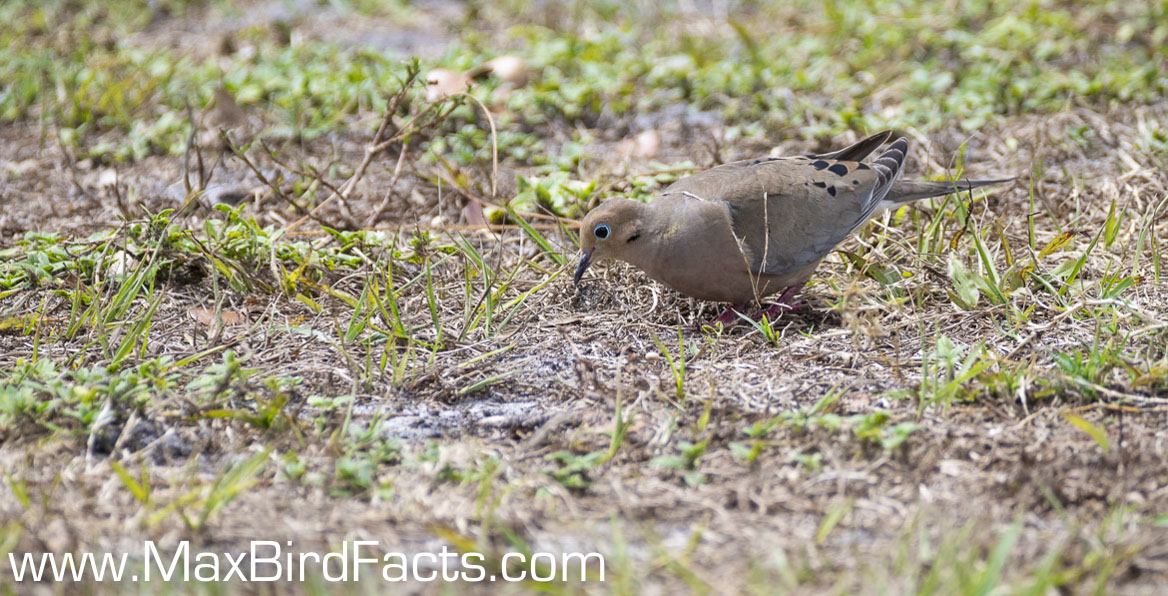
The dove’s song is also a good indicator.
The Mourning Dove makes a Perch-coo-coo-oo call; listening to it brings back a lot of nostalgia for me. The Eurasian Collared-Dove produces a raspier koo-KOO-kok song.
Listening to these side by side, it’s easy to discern which species is which, but sometimes it isn’t as apparent in the field. Fortunately, like other singing birds, these doves will generally perch in an open area while singing.
So if you can’t identify the song, start zeroing in on where it’s originating from and spot the visual differences we’ve talked about before.
Now We Know How to tell a Mourning Dove from a Eurasian Collared Dove
The fastest way to identify if you are looking at a Mourning Dove or a Eurasian Collared-Dove is to look at the bird’s neck.
If you see a broad, dark band running around the back of the neck, this is a Eurasian Collared-Dove. However, if you don’t see a band and instead there is a small black spot on the dove’s cheek, this is a Mourning Dove.
Also, consider the color of the eyes, feet, orbital rings, and the dorsal and ventral aspects we went over. Before you go, I want to recap the five most important features to watch for when identifying these doves in the field.
Below is a small cheat sheet I came up with, and there is a link to download this if you would like to use it.

I really hope you enjoyed reading this and picked up some new knowledge as well. If you have any suggestions for future articles or topics you want to learn more about, please leave a comment below or shoot me an email.
Get Outside & Happy Birding!!!
Max
Discover more from Welcome to MaxBirdFacts.com!!!
Subscribe to get the latest posts sent to your email.

Great content! Keep up the good work!
Thank you so much!!! I hope you enjoy some of my other articles too!
Enjoyed your informative article. A neighbor and I watch these different doves interact and we’ve seen the Eurasian bird be aggresive toward the mourning dove. Also, this is the second year the Eurasian has been in our neck of the woods (ND); how was it introduced here?
Thank you for the comment and kind words, Paul!!! Those Eurasian doves most likely were introduced into your area through hunting camps or released birds for dove hunts. We’ve seen a huge boom of the introduced doves and pheasants here in central Florida because of hunters missing the mark on released fowl (thankfully for the birds). I wouldn’t be surprised at all if this is the same case for you up in North Dakota, and hopefully, your native Mourning Doves will be able to adapt to their new neighbors. Thank you again, and I’m really glad you enjoyed the article!!